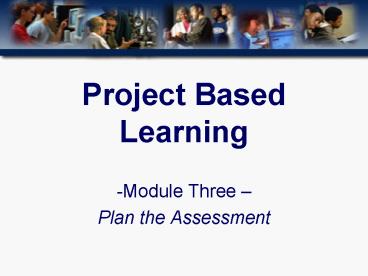Project Based Learning - PowerPoint PPT Presentation
1 / 26
Title:
Project Based Learning
Description:
Project Based Learning. Outcomes. Participants will be able to: ... Module 2: Craft the Driving Question. Module 3: Plan the Assessment. Module 4: Map the Project ... – PowerPoint PPT presentation
Number of Views:321
Avg rating:3.0/5.0
Title: Project Based Learning
1
Project Based Learning
- Module Three
- Plan the Assessment
2
Outcomes
- Participants will be able to
- define authentic and traditional assessment and
give examples of each. - develop an effective assessment plan for
project-based learning - develop quality rubrics
3
(No Transcript)
4
(No Transcript)
5
Project Based Learning
Module 2 Craft the Driving Question
Module 1 Begin With the End in Mind
Module 3 Plan the Assessment
Module 4 Map the Project
Module 5 Manage the Process
6
Planning Phase
- What do you want students to learn?
- Subject Area knowledge (facts, concepts,
principles and generalizations) and procedural
knowledge (skills, processes, and procedures) - How should it be assessed?
- How should it be taught?
7
Authentic Assessment
8
Creating a Balanced Assessment Plan
- Evidence that students have acquired the range of
outcomes expected - Tests
- Research papers
- Product or performance
- Formative and Summative Assessment
9
The student will demonstrate an understanding of
statistics by gathering, interpreting, and
graphing data.
In your group design an assessment plan. Use
content from your own subject matters. Identify
the tools you will need for each assessment (e.g.
test, product, presentation). Be sure to use
technology as an assessment tool.
10
Align Products with Outcomes
- Unpack content standard and skills
- Describe performance and products and how each
relates back to the standards - Describe culminating products
- Checkpoints for feedback (formative)
- Give feedback on artifacts of progress
11
Culminating Products
- Research Paper
Multimedia Shows
Reports
Presentations Within the School
Exhibitions Outside of School
12
If we dont improve assessment, well never
reform our schools. To raise standards, schools
must measure whether or not students can actually
apply their knowledge to real-world
situations. Student assessments need Rigor and
Relevance to be truly effective. Williard
Daggett
13
- Rigor is defined by Blooms Taxonomy
- Evaluation
- Synthesis
- Analysis
- Application
- Understanding/Comprehension
- Awareness
- Relevance is defined by Application Taxonomy
- Real World Unpredictable
- Real World Predictable
- Across Disciplines
- Apply to 1 Discipline
- Knowledge in 1 Discipline
14
(No Transcript)
15
How do we Evaluate Culminating Products
- Rubrics contain the criteria by which you assess
performance and products - Have students participate in developing rubrics
- Share models
16
Rubrics
- Share examples of rubrics in real life.
17
Are you a Rubricator?
18
Types of Rubrics
- Holistic address the product, performance or
process as a whole - Analytic address component parts or
characteristics of product, performance or
process equally
19
Guidelines for writing a rubric
- Each rubric has elements, scales, and criteria
- Each major product in a project requires a
rubric.
20
Elements
- Individual components
- Teamwork
- Content accuracy
- Impact of performance
21
Scales
- Levels of performance (e.g. basic, proficient,
advanced) - Even number of points tends to give a truer score
- Make sure the language of the points matches the
standard(s)
22
Criteria
- Specific descriptors to measure success
- The rubric must be built from an exemplary level
- Show an outstanding model
23
Is there an Ideal number of quality scales?
- Nodepends on purpose
- Teachers ability to clearly and precisely
differentiate - Important the teacher and student should be able
to distinguish and describe performance at the
next level for improvement
24
What is an excellent rubric?
- Evaluates the target accurately and consistently
- Is clear to everyone using it
- Focuses on the characteristics that distinguishes
quality - Is based on actual examples of student work
25
Rubrics establish the dimensions of quality
- Can you recognize quality?
- What is your rubric for a quality pizza?
- Develop the elements (e.g.taste), develop the
scale and the criteria. - Remember describe the ideal target first and
then the rubric - Work in your group
26
Online Rubic Builder
- Rubistar
- http//rubistar.4teachers.org/index.php































